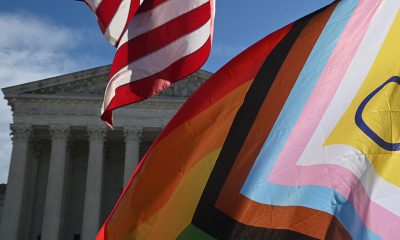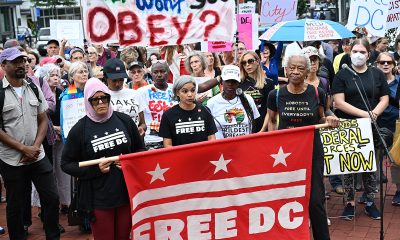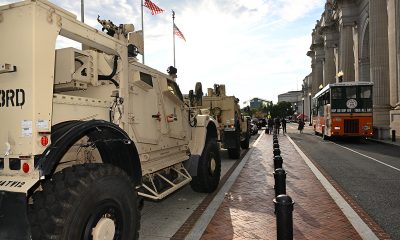a&e features
New co-pastors settle into life at Calvary Baptist
Former S.C. residents are partners in life and ministry
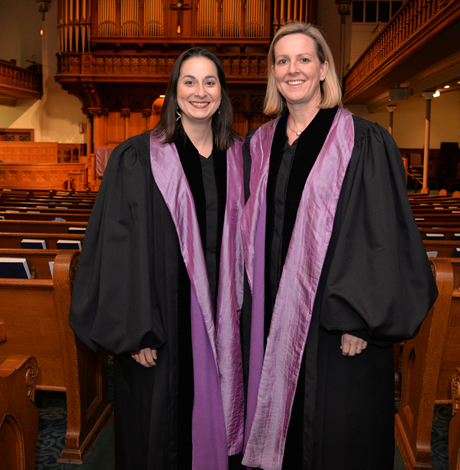
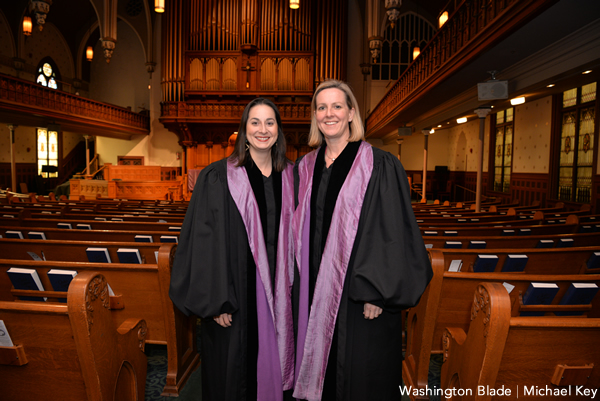
Revs. Sally Sarratt and Maria Swearingen say their pastoral strengths complement each other nicely. (Washington Blade photo by Michael Key)
As a child, Rev. Maria Swearingen felt a connection to the sacraments of the church in a way that was, looking back, perhaps unusual.
Helping her grandfather fill communion trays with crackers and grape juice on Saturday afternoons and seeing the table set on Sunday mornings knowing she’d had a hand in it, made her feel “overcome with just this profound sense of joy, that I participated in the setting of the table,” she says.
Those are skills she and her wife, Rev. Sally Sarratt will put to good use as co-senior pastors of Calvary Baptist Church in Chinatown. Their first Sunday was Feb. 26, so they’re still getting used to their new roles, their first joint pastorate.
Sarratt was previously a hospital chaplain and was filling in for a minister on sabbatical at Greenville Unitarian Universalist Fellowship in Greenville, S.C. Swearingen was associate university chaplain at Furman University and spent the last year working with a cohort of clergy to develop a year-long training program for religious leaders focused on dismantling white supremacy and racism.
The couple, together since late 2009 (they’d met the previous year at church), weren’t necessarily looking for a co-pastorate but it was something they’d dreamed and talked about. Calvary’s last pastor, Rev. Amy Butler, left in 2014 to become senior pastor at New York’s famed Riverside Church, one of the few progressive non-denominational churches in the country. Rev. Allyson Robinson, who’s transgender, was interim minister. Sarratt and Swearingen say their sexual orientation (they both identify as lesbians) was a non-issue.
“The fact that we happened to be a same-sex couple wasn’t even part of their conversation,” Sarratt says. “Calvary had already kind of done the work to say, ‘Look, we’re welcoming and affirming,’ … so it really wasn’t an issue for the (search) committee.”
The job ad said the church was open to considering a co-pastorate. They both work at the church full time and say their gifts and strengths are different enough as to be complementary, although they share preaching duties. Mostly either one or the other will deliver the sermon, but they are experimenting with co-sermonizing, an idea they’re toying with for Easter Sunday.
“As we met and talked with Sally and Maria about their vision for pastoral leadership … we were struck by their deep faith and commitment to being part of a gospel community,” says Carol Blythe, chair of the search committee. “We were impressed by how their gifts, talents and experience matched our ministry priorities and we’re thrilled about their upcoming pastorate and the versatility the co-pastor model will provide our congregation.”
Sarratt says the compensation package the church offered them “is very fair.”
So is it unusual for a Baptist church to be so open-minded? Not really. Calvary is part of the American Baptist Churches USA movement, which has about 1.3 million members in about 5,000 congregations. There are 42 million Baptists around the world that trace their tradition to the early 17th century. Calvary has no ties to the Southern Baptist Convention, the largest Protestant group in the United States with about 15 million members and a much more conservative, anti-gay agency.
Sarratt and Swearingen grew up in more conservative strains of the denomination and though they each attended Methodist seminaries, they have strong Baptist roots. Swearingen remembers some “fire and brimstone” preaching in her youth but says her theology has evolved.
Swearingen says to her, being Baptist means valuing separation of church and state, religious liberty and belief in the priesthood of all believers.
“That’s kind of the gift of what Baptist life can be, that’s what the word can hold,” she says. “For quite some time, it hasn’t looked that way in lots of spaces that call themselves Baptist, but I’m all about being invested in reclaiming that word.”
Looking back, though, she says she’s amazed that even in the theology of her youth, progressive beliefs managed to seep in.
“What I think is so uncanny and persnickety about the way the gospel can work is … the overturning and upturning of unjust, un-mutual systems of power, these things would still find their way into the cracks and crevices,” she says. “The goodness of faith life and practices was findings its way to me even amidst really problematic and damaging theology and it’s really what we, ministry wise, are invested in as much as anything. How do we unearth and let go of and heal from all kinds of theological language that really has just been a perpetuation of oppression and really find freedom and release from that so we can use and live inside language that actually invites wholeness?”
It’s a recurring theme in her ministerial philosophies and similar strains pop up when asked about the future of the mainline church, trends in church attendance among Millennials and even what lessons the Easter message has for today.
Sarratt says for her, getting to that place has been a process. She speaks of “digging and deconstructing and reconstructing” various theology over time.
“One of the things I worry about and feel sad about is the fact that in many ways, queer people still think, ‘I either choose my faith or I choose who I am,’” Sarratt says. “The integration and wedding of the two and either one being able to bless the fullness of who you are is still kind of a rare thing.”
Neither Sarratt nor Swearingen were out when they met in the summer of 2008. Both planning to pursue full-time ministry and didn’t see any way to be out, especially in the Bible Belt, while being pastors.
“Mariah was headed back to school in Durham and it was one of those things like, ‘Well, that was great, but I’m feeling called to ministry so this can’t happen, it can’t be,’” Sarratt says.
But their connection — Swearingen says, “You know, love — yada, yada” — was persistent.
“By the fall of 2009 we were kind of like, ‘Yeah, this is so real and profound, how do we choose both of these paths?’ We didn’t know but we started saying, maybe it’s time to start walking in that direction … of trying to do ministry and family and life together,” Sarratt says.
Coming out, she says, was a “long, slow, cautious, careful process.”
Swearingen says it came down to the decision all out LGBT people eventually make. “Am I choosing to live embodied in my real self or in some constructed reality of me,” she says. “Freedom always comes when we keep pressing more into our authentic selves. … and it’s deep, difficult work of … really claiming and choosing one’s self.”
Sarratt calls it “being able to see one’s self as a beloved child of God.”
Eventually there were three marriages of sorts. They privately shared vows in 2011, had a commitment ceremony with family and friends in 2014 and made it legal as soon as they could the Tuesday before Thanksgiving in 2014 at a Greenville courthouse.
They say early signs at Calvary are positive. They’re spending the first several months meeting individually with staff, board members and parishioners. About a hundred worshippers attend on an average Sunday. Several other congregations and outside groups use the massive downtown facility throughout the week. The couple guesses about 20 percent of the congregation are LGBT.
Sarratt says her strengths are in business, systems thinking and spiritual formation. She says Swearingen, who’s bilingual, is much better at creative worship planning.
“Even if I invested all my time and energy into being a creative worship planner, I’d still only have maybe as much as she has in her pinky,” Sarratt says. “It’s just one of those things where you get to use your gifts without having to shore up those parts of the job you’re not as good at naturally.”
They say they’re mindful of falling into potential trouble areas — not making time for a life outside of church together or the possibility of getting swept up in church politics. Or even, perhaps more innocuously, finding some factions of the congregation favoring one over the other.
So what will success look like? And with society slowly shifting toward progress on LGBT and all kinds of issues, why are the big, downtown, progressive churches often struggling while the anti-gay evangelical churches continue to thrive?
“It’s hard to kind of treat the litmus test if you will as large swaths of people who can afford big buildings,” Swearingen says. “But if you’re imagining the work of justice building and peace building, those are movements that don’t always create a success that can be pointed to, which, quite simply, wouldn’t be what I’d call a goal I’d get excited about. It’s the work itself, the outcomes and the goals are different.”
She says looking at the work through that alternate lens creates a much different perspective on effective ministry.
“For me, the questions would be are the people who have understood themselves to be marginalized, dispossessed and oppressed, finding space to be whole? If the answer to that is yes, then we’re being the church, but if the answer is, ‘I’m not so sure, but look at this really cool building we just built,’ I struggle to call those outcomes fruitful church work.”
New Calvary pastors share favorites
Favorite hymn?
SWEARINGEN: “Great is Thy Faithfulness,” but especially Yvette Flunder’s version when she says, “Oh God my father and mother.” I love that.
SARRATT: Since we’re in Lent, I’m thinking more in those terms right now so I like some of the more reflecting ones like “Abide With Me” or “O Sacred Head Now Wounded.”
Favorite scripture?
SWEARINGEN: “Do not grow weary in doing good for at the proper time, you will reap a harvest if you do not give up.” (Galatians 6:9)
SARRATT: The sermon on the mount, especially the Beatitudes.
Favorite biblical figure?
SWEARINGEN: Ruth and Naomi.
SARRATT: Job. We need to reclaim the fullness of emotion and lament and not just sanitize everything. The older I get, the more I’ve found a deep and profound honesty in those places.
a&e features
Queer highlights of the 2026 Critics Choice Awards: Aunt Gladys, that ‘Heated Rivalry’ shoutout and more
Amy Madigan’s win in the supporting actress category puts her in serious contention to win the Oscar for ‘Weapons’

From Chelsea Handler shouting out Heated Rivalry in her opening monologue to Amy Madigan proving that horror performances can (and should) be taken seriously, the Critics Choice Awards provided plenty of iconic moments for queer movie fans to celebrate on the long road to Oscar night.
Handler kicked off the ceremony by recapping the biggest moments in pop culture last year, from Wicked: For Good to Sinners. She also made room to joke about the surprise hit TV sensation on everyone’s minds: “Shoutout to Heated Rivalry. Everyone loves it! Gay men love it, women love it, straight men who say they aren’t gay but work out at Equinox love it!”
The back-to-back wins for Jacob Elordi in Frankenstein and Amy Madigan in Weapons are notable, given the horror bias that awards voters typically have. Aunt Gladys instantly became a pop culture phenomenon within the LGBTQ+ community when Zach Cregger’s hit horror comedy released in August, but the thought that Madigan could be a serious awards contender for such a fun, out-there performance seemed improbable to most months ago. Now, considering the sheer amount of critics’ attention she’s received over the past month, there’s no denying she’s in the running for the Oscar.
“I really wasn’t expecting all of this because I thought people would like the movie, and I thought people would dig Gladys, but you love Gladys! I mean, it’s crazy,” Madigan said during her acceptance speech. “I get [sent] makeup tutorials and paintings. I even got one weird thing about how she’s a sex icon also, which I didn’t go too deep into that one.”
Over on the TV side, Rhea Seehorn won in the incredibly competitive best actress in a drama series category for her acclaimed performance as Carol in Pluribus, beating out the likes of Emmy winner Britt Lower for Severance, Carrie Coon for The White Lotus, and Bella Ramsey for The Last of Us. Pluribus, which was created by Breaking Bad’s showrunner Vince Gilligan, has been celebrated by audiences for its rich exploration of queer trauma and conversion therapy.
Jean Smart was Hack’s only win of the night, as Hannah Einbinder couldn’t repeat her Emmy victory in the supporting actress in a comedy series category against Janelle James, who nabbed a trophy for Abbott Elementary. Hacks lost the best comedy series award to The Studio, as it did at the Emmys in September. And in the limited series category, Erin Doherty repeated her Emmy success in supporting actress, joining in yet another Adolescence awards sweep.
As Oscar fans speculate on what these Critics Choice wins mean for future ceremonies, we have next week’s Golden Globes ceremony to look forward to on Jan. 11.
a&e features
Looking back at the 10 biggest A&E stories of 2025
‘Wicked,’ Lady Gaga’s new era, ‘Sexy’ Bailey and more

Although 2025 was a year marked by countless attacks on trans rights and political setbacks, the year also saw brilliant queer artists continuing to create art. From Cannes and Sundance Award winners now vying for Oscar consideration to pop icons entering new stages of their careers, queer people persevered to tell their stories through different media.
With the state of the world so uncertain, perhaps there’s no more vital time to celebrate our wins, as seen through some of this year’s top pop culture moments. While there’s no collection of 10 stories that fully encompass “the most important” news, here are some events that got the gays going:
10. ‘Mysterious Gaze of the Flamingo’ wins big at Cannes

The Cannes Film Festival has become a crucial start for films hoping to make their way to the Oscars, and first-time director Diego Céspedes won the top Un Certain Regard prize for his intimate western “The Mysterious Gaze of the Flamingo.” The film is set in the ‘80s and is intended as an allegory for the AIDS epidemic. Seeing a film that unpacks vital queer history win one of the most coveted awards at Cannes has been a huge point of pride in the independent filmmaking community.
Since the film bowed at Cannes, it has been selected as Chile’s Oscar entry in the Best International Feature race. Speaking with The Blade during the film’s AFI Fest run in October, Céspedes said: At first, I was kind of scared to have this campaign position in the times that we’re living [in] here. But at the same time, I think the Oscars mean a huge platform — a huge platform for art and politics.”
9. ‘The Last of Us’ returns for an even gayer season 2
While the first season of The Last of Us gave us one of TV’s most heartbreaking queer love stories in the episode “Long, Long Time,” Season 2 doubled down on its commitment to queer storytelling with the blossoming relationship between Ellie (Bella Ramsey) and Dina (Isabela Merced). The show expanded on the pair’s relationship in the original video game, making it perhaps the central dynamic to the entire season. That unfortunately came with more homophobic backlash on the internet, but those who checked out all the episodes saw a tender relationship form amid the show’s post-apocalyptic, often violent backdrop. For their performance, Ramsey was once again nominated for an Emmy, but Merced deserved just as much awards attention.
8. ‘Emilia Pérez’ sparks controversy
Jacques Audiard’s genre-bending trans musical “Emilia Pérez” proved to be an awards season juggernaut this time last year, winning the Golden Globe for Best Musical/Comedy. But when the lead star Karla Sofia Gascón’s racist, sexist, and homophobic old tweets resurfaced, the film’s Oscar campaign became a tough sell, especially after Netflix had tried so hard to sell Emilia Pérez as the “progressive” film to vote for. Mind you, the film had already received significant backlash from LGBTQ+ audiences and the Mexican community for its stereotypical and reductive portrayals, but the Gascón controversy made what was originally just social media backlash impossible to ignore. The only person who seemed to come out of the whole debacle unscathed was Zoe Saldaña, who won the Oscar for Best Supporting Actress over Ariana Grande.
7. ‘Sorry, Baby’ establishes Eva Victor as major talent
Back in January at the Sundance Film Festival, Eva Victor (known by many for her brand of sketch comedy) premiered their directorial debut “Sorry, Baby” to rave reviews, even winning the Waldo Salt Screening Award. Victor shadowed Jane Schoenbrun on the set of “I Saw the TV Glow,” and seeing Victor come into their own and establish such a strong voice immediately made them one of independent cinema’s most exciting new voices. A memorable scene in the film sees the main character, Agnes (played by Victor), struggling to check a box for male or female, just one example of how naturally queerness is woven into the fabric of the story.
Most recently, Victor was nominated for a Golden Globe for her performance in the film, and she’s represented in a category alongside Jennifer Lawrence (“Die My Love”), Jessie Buckley (“Hamnet”), Julia Roberts (“After the Hunt”), Renate Reinsve (“Sentimental Value”) and Tessa Thompson (“Hedda”). The film also received four Independent Spirit Award nominations overall.
6. Paul Reubens comes out in posthumous doc

While Paul Reubens never publicly came out as gay before passing away in 2023, the two-part documentary “Pee-wee as Himself” premiered back in May on HBO Max, giving the legendary comedian a chance to posthumously open up to the world. Directed by Matt Wolf, the documentary explores how Reubens found his alter ego Pee-Wee Herman and why he kept his private life private.
The documentary won an Emmy in the Outstanding Documentary or Nonfiction Special category and remains one of the most critically acclaimed titles of the year with a 100% Rotten Tomatoes score. Also worth noting, the National Geographic documentary Sally told the posthumous coming out story of Sally Ride through the help of her long-time partner, Tam O’Shaughnessy.
5. Lady Gaga releases ‘Mayhem’
Lady Gaga entered a new phase of her musical career with the release of Mayhem, her seventh album to date. From the frenzy-inducing pop hit Abracadabra to the memorable Bruno Mars duet featured on “Die With a Smile,” seeing Gaga return to her roots and make an album for the most die-hard of fans was especially rewarding after the underwhelming film releases of “House of Gucci” and “Joker: Folie à Deux.” Gaga has been touring with The Mayhem Ball since July, her first arena tour since 2018. She even extended her tour into 2026 with more North American dates, so the party isn’t stopping anytime soon. And Gaga is even set to make an appearance next May in “The Devil Wears Prada 2.”
4. Cynthia Erivo, Ariana Grande perform at the Oscars

While “Wicked: For Good” didn’t quite reach the heights of the first film, we will forever have Cynthia Erivo and Ariana Grande’s breathtaking live performance that opened the 97th Academy Awards. The pair sang a rendition of “Over the Rainbow,” “Home,” and “Defying Gravity,” paying proper homage to the original 1939 “Wizard of Oz.” Even non-Wicked fans can’t deny how magical and brilliantly staged this performance was. With both Erivo and Grande up for acting Oscars last year, they’re hoping to repeat success and make history with consecutive nominations. Either way, let’s hope there’s another live performance in the making, especially with two new original songs (The Girl in the Bubble and No Place Like Home) in the mix.
3. Indya Moore speaks out against Ryan Murphy
Indya Moore has consistently used social media as a platform for activism, and in September, posted a 30-minute Instagram live speaking out against “Pose” co-creator Ryan Murphy. Moore claimed that Murphy wasn’t being a true activist for trans people. “Ryan Murphy, we need you to do more. You need to address the racism, the violence, and the targeting of people on your productions, Ryan Murphy. You do need to make sure trans people are paid equally. Yes, Janet did the right thing,” Moore said. Murphy was also back in the headlines this year for the critically panned “All’s Fair” and the controversial “Monster: The Ed Gein Story” starring Laurie Metcalf and Charlie Hunnam.
2. Cole Escola wins Tony for Best Leading Actor
Few pop culture moments this year brought us together more than Cole Escola winning a Tony award for “Oh, Mary!” the Broadway show they created, wrote and starred in (we love a triple threat!) Escola made history by becoming the first nonbinary person to win a Tony in the leading actor category, and seeing them excitedly rush to the stage wearing a Bernadette Peters-inspired gown instantly became a viral social media moment.
The cherry on top of Escola’s major moment is the recent news that they are writing a Miss Piggy movie with Jennifer Lawrence and Emma Stone producing — news that also broke the internet for the better. We cannot wait!
1. Jonathan Bailey makes gay history as ‘Sexiest Man Alive’

The same year as his on-screen roles in blockbusters “Jurassic World Rebirth” and “Wicked: For Good,” Jonathan Bailey made history as the first openly gay man to be named People magazine’s “Sexiest Man Alive.” The fact that it took 40 years for an openly gay man to earn the title is a signifier of how far we still have to go with queer representation, and seeing Bailey celebrated is just one small step in the right direction.
“There’s so many people that want to do brilliant stuff who feel like they can’t,” he told PEOPLE, “and I know the LGBT sector is under immense threat at the moment. So it’s been amazing to meet people who have the expertise and see potential that I could have only dreamed of.” In 2024, Bailey founded the charity titled The Shameless Fund, which raises money for LGBTQ+ organizations.
a&e features
Your guide to D.C.’s queer New Year’s Eve parties
Ring in 2026 with drag, leather, Champagne, and more

With Christmas in the rear view mirror, we can turn our attention to ringing in a much-anticipated New Year with a slew of local LGBTQ parties. Here’s what’s on tap.
Pitchers
This spacious Adams Morgan bar is hosting the “Pitchers’ Perfect New Year’s Eve.” There will be a midnight Champagne toast, the ball drop on the big screens, and no cover, all night long. The bar doesn’t close until 4 a.m., and the kitchen will be open late (though not until close). All five floors will be open for the party, and party favors are promised.
Trade
D.C.’s hottest bar/club combo is leaning into the Shark motif with its NYE party, “Feeding Frenzy.” The party is a “glitterati-infused Naughty-cal New Year’s Even in the Shark Tank, where the boats are churning and the sharks are circling.” Trade also boasts no cover charge, with doors opening at 5 p.m. and the aforementioned Shark Tank opening at 9 p.m.. Four DJs will be spread across the two spaces; midnight hostess is played by Vagenesis and the two sea sirens sensuously calling are Anathema and Justin Williams.
Number Nine
While Trade will have two DJs as part of one party, Number Nine will host two separate parties, one on each floor. The first floor is classic Number Nine, a more casual-style event with the countdown on TVs and a Champagne midnight toast. There will be no cover and doors open at 5 p.m. Upstairs will be hosted by Capital Sapphics for its second annual NYE gathering. Tickets (about $50) include a midnight Champagne toast, curated drink menu, sapphic DJ set by Rijak, and tarot readings by Yooji.
Crush
Crush will kick off NYE with a free drag bingo at 8 p.m. for the early birds. Post-bingo, there will be a cover for the rest of the evening, featuring two DJs. The cover ($20 limited pre-sale that includes line skip until 11 p.m.; $25 at the door after 9 p.m.) includes one free N/A or Crush, a Champagne toast, and party favors (“the legal kind”). More details on Eventbrite.
Bunker
This subterranean lair is hosting a NYE party entitled “Frosted & Fur: Aspen After Dark New Year’s Eve Celebration.” Arriety from Rupaul Season 15 is set to host, with International DJ Alex Lo. Doors open at 9 p.m. and close at 3 p.m.; there is a midnight Champagne toast. Cover is $25, plus an optional $99 all-you-can-drink package.
District Eagle
This leather-focused bar is hosting “Bulge” for its NYE party. Each District Eagle floor will have its own music and vibe. Doors run from 7 p.m.-3 a.m. and cover is $15. There will be a Champagne toast at midnight, as well as drink specials during the event.
Kiki, Shakiki
Kiki and its new sister bar program Shakiki (in the old Shakers space) will have the same type of party on New Year’s Eve. Both bars open their doors at 5 p.m. and stay open until closing time. Both will offer a Champagne toast at midnight. At Kiki, DJ Vodkatrina will play; at Shakiki, it’ll be DJ Alex Love. Kiki keeps the party going on New Year’s Day, opening at 2 p.m., to celebrate Kiki’s fourth anniversary. There will be a drag show at 6 p.m. and an early 2000s dance party 4-8 p.m.
Spark
This bar and its new menu of alcoholic and twin N/A drinks will host a NYE party with music by DJ Emerald Fox. Given this menu, there will be a complimentary toast at midnight, guests can choose either sparkling wine with or without alcohol. No cover, but Spark is also offering optional wristbands at the door for $35 open bar 11 p.m.-1 a.m. (mid-shelf liquor & all NA drinks).
-

 Sponsored5 days ago
Sponsored5 days agoSafer Ways to Pay for Online Performances and Queer Events
-

 District of Columbia4 days ago
District of Columbia4 days agoTwo pioneering gay journalists to speak at Thursday event
-

 Colombia4 days ago
Colombia4 days agoBlade travels to Colombia after U.S. forces seize Maduro in Venezuela
-

 a&e features4 days ago
a&e features4 days agoQueer highlights of the 2026 Critics Choice Awards: Aunt Gladys, that ‘Heated Rivalry’ shoutout and more

